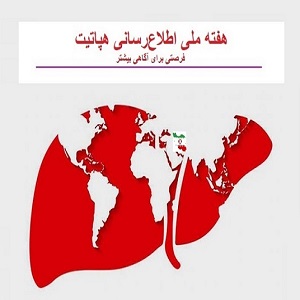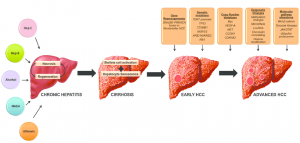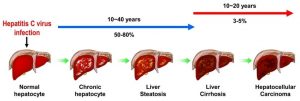National Hepatitis Awareness week; Healthy lifestyle is the most important way to prevent
Hepatitis means inflammation and swelling in the liver and is caused by various causes such as the use of certain drugs, alcohol, pathogens such as viruses, or disorders of the immune system and etc. Hepatitis is divided into two types: acute and chronic:
Acute hepatitis refers to cases that last less than six months and the liver disease sometimes completely improves and the liver returns to normal or an acute attack causes the liver tissue to die within a short period of time.
Chronic hepatitis refers to cases in which inflammatory changes in the liver persist for more than six months.
As mentioned, one of the major causes of hepatitis is viruses. Viral hepatitis is mainly caused by six hepatitis A, B, C, D, E and G viruses.
TYPE OF VIRUS | OCCURNESE | Incubation period |
A | Acute like the flu | (15-50 days) |
B | Sometimes gradual or acute | (28-160 days) |
C | Gradually | (14-150 day) |
D | Acute | (unknown) |
E | Acute and suddenly | (15-64 day) |
G | Sometimes gradual or acute | (14-20 day) |
- The incubation period of the disease is called for the time interval between the entry of the virus into the body until the onset of clinical symptoms. For hepatitis B is about 2-3 months.
- The serological incubation period is called for the time interval between the entry of the causative agent of infection into the body and the positive serological indicators of infectivity. For example for hepatitis B is up to 30 days.
Prevalence of viral hepatitis infections:
Types A and E are common infections under adverse health conditions and often occur at an early age and are transmitted through fecal-oral transmission.
Types B and C of the disease have 1% fatality. Annually about 1.5-1 million people die of hepatitis complications.
Hepatitis A:
- It is a contagious disease in which patients are the main source of infection and the disease can be transmitted through contaminated water and food, contaminated hands, and utensils (dishes).
- The virus is excreted in the feces for one to two weeks before the onset of the disease and for up to two weeks after that, there is a risk of transmission to others.
- Hepatitis A is rarely transmitted through blood and blood products.
Hepatitis B:
- Humans are the only natural hosts of the virus.
- Hepatitis B is so prevalent that most people in the world are currently infected with HBV (Hepatitis B Virus) and about 300 million of them are carriers or chronic carriers of the infection who have symptoms of liver disease. They do not have either.
- In the latent period of the disease and in its acute stage, the virus is present in the blood.
The virus has a long incubation period of 6 weeks to 6 months. - The virus is present in blood, serum, urine, and body fluids (saliva, vaginal secretions, and sperm).
Hepatitis C:
- Chronic hepatitis C is one of the leading causes of chronic liver disease with increasing mortality worldwide.
- There are about 170 million people with chronic hepatitis C in the world who are exposed to hepatic and extrahepatic manifestations. Hepatitis C infection may lead to cirrhosis, gastrointestinal bleeding, liver failure, and malignancy (cancer).
- Hepatitis C has become an international problem today and is the most common cause of viral hepatitis in dialysis patients.
- No specific vaccine has yet been developed for HCV; Therefore, observing standard precautions in hemodialysis wards to prevent transmission has a critical and special role.
Hepatitis G:
- It is commonly transmitted by injection and is more common in blood recipients or blood products, as well as in people on dialysis.
- The disease caused by this virus usually appears as mild hepatitis.
Clinical signs may include the following:
- Ague (fever and shivering)
- Lose of appetite
- Fatigue and laziness and lethargy and weakness
- Headache, nausea, and vomiting
- Colored urine and pale stools
- Pain and tenderness in the area below the right rib
- Conjunctival jaundice of the skin
- Changes in liver enzymes
Methods of transmission based on hepatitis virus type:
- Type A: fecal-oral, contact with patients
- Type B: Blood transfusions and blood products, sexual transmission, mother-to-child transmission, tattooing, ear-piercing, shared toothbrush, acupuncture, contaminated laboratory equipment, dialysis department, and dental offices, etc.)
- Types C and G: Blood transfusions, sexual contact, organ transplants, tattoos, ear piercings
- Type D: such as hepatitis B.
- Type E: Consumption of contaminated water, feces-mouth
Primary prevention:
Hepatitis A:
- Observance of personal hygiene and provision of public health
- Measures such as chlorination of drinking water, heating and boiling for 5 minutes in boiling water
- Separate food containers, spoons, and forks.
- If the patient is hospitalized, he should be periodically isolated.
- The vaccine can be used by those in the high-risk group.
- The use of proprietary antibodies is also used for prevention in those who are at high risk of infection.
Hepatitis B:
- Raising the health awareness of people, especially people at risk.
- Vaccination of high-risk groups:
- Medical-Paramedical Society
- Dialysis patients
- Hospital staff and patient care centers for children and the elderly
- Recipients of blood products
- Municipal sweepers
- Specific antibody injections for those who had a high-risk exposure within 48 hours.
Laboratory diagnosis of viral hepatitis:
Diagnosis of viral hepatitis is possible mainly through antigen detection methods or antibodies in patients’ blood, and in some cases, such as hepatitis C, molecular PCR tests are required to confirm the above tests.




